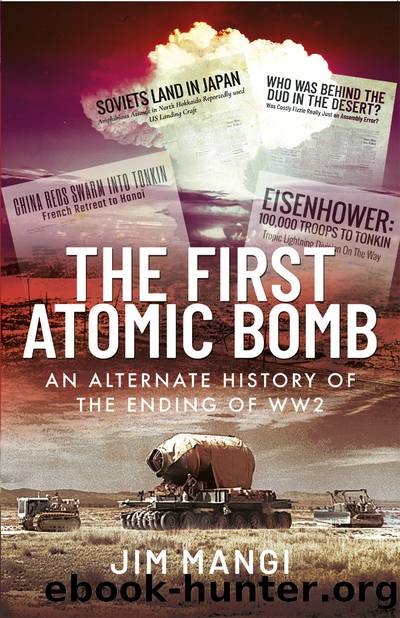The First Atomic Bomb by Unknown

Author:Unknown
Language: eng
Format: epub
ISBN: 0000000000000
Published: 2022-09-08T19:32:46+00:00
1. See âWhat Really Happenedâ (Sep 1951 (2)).
2. See âWhat Really Happenedâ (Jul 1950 (2)).
3. See âWhat Really Happenedâ (1968â2010).
Chapter 22
Korea From 1945
The establishment of Peopleâs Committees in Korean provinces followed on the heels of Soviet troops (Buzo). Such committees were populated, but not wholly dominated, by Korean communists; other left-leaning groups were also major players. In September in Pyongyang, prominent Christian leader Cho Man-sik set up a Committee To Prepare For Korean Independence. This group also included communists, such as Pak Hon-yong, who had survived the years of Japanese rule. Initially, the Soviets promised to work with this diverse group. However, in October the Soviet authorities set up an Interim Korean Peopleâs Committee, with non-communist Cho as its nominal head but with communists coming into a dominant role. To further help the locals run things, the Soviets in October repatriated several hundred Koreans who had spent the war in Manchuria and the Soviet Union as guerrillas fighting the Japanese. Among these was a native Korean named Kim Il-sung. The Soviets touted his exploits in Manchuria against the Japanese almost as soon as he arrived back in Korea (Seth). The Soviets began promoting Kim and his Siberian/Manchurian wartime colleagues over the native communists, all the while sliding non-communist Cho Man-sik and even communist Pak Hon-yong to the side. In December, the Soviets made Kim head of the Korean Communist Party, replacing the provincial peopleâs committees (Seth).
The Great Powers held a Foreign Ministersâ Conference in Moscow in December 1945 (Leckie). The conferees agreed to a four-power (US, USSR, UK and China) trusteeship for Korea to last 4 or 5 years. The Soviets agreed to this trusteeship (Seth). It is likely they were confident that the multi-party but communist-dominated Korean governance structure would be readily responsive to the guidance of the Soviet Union, whose troops had lifted the yoke of Japanese oppression, and still walked the streets of Pyongyang, Seoul, Pusan and other cities throughout the peninsula. The Soviets further believed that they well understood Korea and its people through the help of a large number of Soviet citizens of Korean descent then living in the Soviet Far East (Spector).
The US made noises at the conference and later about the need for the other three powers overseeing the trusteeship to have a meaningful role in guiding that Korean government. With straight faces the Soviets promised to cooperate fully, indeed as fully as MacArthurâs SCAP HQ in Tokyo cooperated with the four-power Allied Council for Japan. That is to say, as the US owned the occupation of South Japan, the USSR would own the Korean trusteeship.
But the feasibility of the trusteeship was challenged first and most strongly by the Koreans themselves. The 1943 Cairo Conference with US, UK and Chinese leaders had produced a declaration that âin due course Korea shall become free and independentâ. At the 1945 Yalta Conference the Big Three agreed to set up a Great Power trusteeship for Korea, but they did not specify a duration. FDR may well
Download
This site does not store any files on its server. We only index and link to content provided by other sites. Please contact the content providers to delete copyright contents if any and email us, we'll remove relevant links or contents immediately.
| Biological & Chemical | Conventional |
| Nuclear |
The Radium Girls by Kate Moore(11572)
100 Deadly Skills by Clint Emerson(4650)
The Templars by Dan Jones(4539)
Rise and Kill First by Ronen Bergman(4530)
The Doomsday Machine by Daniel Ellsberg(4224)
The Rape of Nanking by Iris Chang(3995)
Killing England by Bill O'Reilly(3883)
Hitler in Los Angeles by Steven J. Ross(3781)
Stalin by Stephen Kotkin(3697)
12 Strong by Doug Stanton(3399)
Hitler's Monsters by Eric Kurlander(3135)
Blood and Sand by Alex Von Tunzelmann(3032)
Darkest Hour by Anthony McCarten(2998)
The Code Book by Simon Singh(2827)
The Art of War Visualized by Jessica Hagy(2815)
Hitler's Flying Saucers: A Guide to German Flying Discs of the Second World War by Stevens Henry(2610)
Babylon's Ark by Lawrence Anthony(2414)
The Second World Wars by Victor Davis Hanson(2409)
Tobruk by Peter Fitzsimons(2362)
